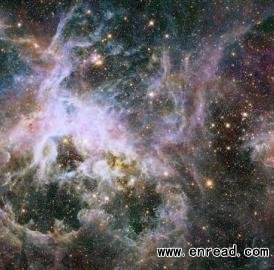
,This new Hubble image is the best-ever view of a cosmic
creepy-crawly(毛骨悚然地) known as the Tarantula
Nebula
1, a region full of star clusters, glowing gas, and dark dust.
Astronomers
2 are exploring and mapping this nebula as part of the Hubble Tarantula
Treasury
3 Project, in a bid to try to understand its
starry
4
anatomy
5. The Tarantula Nebula is located in one of our closest galactic neighbours, the Large Magellanic Cloud. Hubble has released images of this
celestial6(天空的) spider several times before: in 2004 (heic0416), 2010 (heic1008), 2011 (heic1105) and 2012 (heic1206). While these images show striking
panoramic7 views(全景) of this turbulent region, this new image gives us the deepest and most
detailed
8 view yet., ,Created using observations taken as part of the Hubble Tarantula Treasury Project (HTTP), this image is composed of near-
infrared
9 observations from both Hubble's Wide Field Camera 3 (WFC3) and Advanced Camera for Surveys (ACS). Due to the combination of infrared filters in this image a purple
haze
10 fills the frame, with deep red wisps of dust and bright stars
scattered
11 throughout., ,This region is an example of an HII region -- a large cloud of
partially
12 ionised hydrogen within which new stars are being born. Visible to the left of centre is a sparkling star cluster known as R136. It was
initially
13 identified as a star, but astronomers puzzled over how one single
monstrous
14 star could ionise a giant HII region. However, astronomers later realised it was actually a cluster of stars: a super star cluster., ,R136 will eventually become a globular cluster: a
spherical
15 ball of old stars that orbits around the centre of its host
galaxy
16. R136 is so massive that it contributes greatly to the Tarantula's brightness, emitting most of the energy that makes the nebula so visible., ,The Hubble Tarantula Treasury Project (HTTP) is scanning and imaging many of the stars within the Tarantula, mapping out the locations and properties of the nebula's stellar inhabitants. These observations will help astronomers to view the nebula and piece together an understanding of the nebula's structure., ,This new image is being released today, 9 January 2014, at the 223rd meeting of the American
Astronomical
17 Society in Washington, DC, USA.

